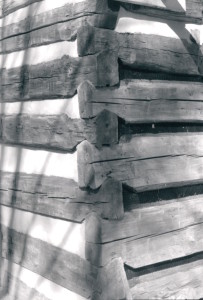Chinking… filling in the area between the logs is probably the single most important aspect of building or restoring a log cabin. It’s also the least appreciated.
Done correctly it will last for decades, it will keep out the rain and the cold, it will protect the logs from water damage, and it can be an attractive feature.
It is also the most numerous request that we get for our services, and a lot of those calls are because most novices do not install it correctly and as a result problems (mainly rot) appear very soon.
This is an area of log construction that “do it right the first time” is very important. Many log homeowners will pay to have it done wrong, then they will pay more than that to have it removed, then they will pay to have repairs done to their logs because of the improper chinking, then they will pay to have it done right. Yikes.
We use a dyed cement mix. It cost about $5 for a five gallon bucket full of it. We do not use PermaChink which cost over $100 a bucket… We don’t like working with a polymer, nor do we like cleaning up after we are finished at the end of the day with toxic chemicals, nor do we feel it is appropriate to apply a modern plastic product to a vintage log cabin. It’s just not the right way to do things.
We like our Frisbees made out plastic, not our historic structures. Yes, I know PermaChink is warranted to last a long time… but how many plastic products do you know that hold up well out in the sun? How many times has a warranty worked out for you?
I’ve been chinking cabins for 30 years… and every cabin I’ve ever chinked is still just as fine today as the day I installed it… not one single chink joint replaced… ever.
Chinking for the most part is a miserable job. It’s painstakingly slow, and the installer is prone to getting painful cuts (I carried one crewman to the hospital to get stitches in his belly from a piece of the wire mesh that he was working with). Even my dentist can tell when I’ve been chinking from the grinding damage to my teeth that I mindlessly do while installing.
I’ll have to see if I can put together some kind of YouTube video and show people how to install chinking properly. My dentist would be happy about that.
Originally posted 2015-03-04 14:27:55.


We are reconstructing a cabin built in 1892. We have the walls up and and are preparing to put the roof on.
There is NO chinking. We will be starting from scratch – and don’t know where to start !! Is there a product we should buy or make ??
This cabin was the original home of my husband’s great grandfather. We have homestead papers to verify it’s origin.
Any help would be appreciated. Thank you.
Congratulations, you own a real treasure! And I am proud of you for saving this part of your families history… you and you descendants will never regret it. There are a lot of things to learn when building or restoring an old cabin, they are not like anything else. It has taken me 30 years to learn what I know. I’m posting a lot of that information free to be had here on this blog, you can read through it all and learn a lot… I wish this info had been available to me years ago. I am available for consultation if you’re interested… even a single day at your cabin would help you immensely. I’m 90 per hour for a single day… if you keep me around for a couple weeks or longer… the rate drops to 70. With regard to you chinking… do not use Permatreat, use a pigmented portland cement. Noah… my personal email is mensax@yahoo.com… send me a photo or two of your cabin!
Hi Noah! I just finished watching all of your videos on YouTube, starting from the very beginning when you did your series on tools. I’ve enjoyed every video and have learned so much. So here I am now, on your website, reading all your posts from the beginning! Thanks for taking the time to share your knowledge and provide thoughtful responses to the questions you receive. My wife and I own some beautiful property in Nellysford, VA, not far from your neck of the woods. We both have been inspired by you and desire to build our own handmade home in the coming years, probably a blended home of log, stone, and timber.. Next step is to join the Handmade House Guild! Thanks again for all you do.
Nellysford is a beautiful area of Virginia… I know the area well!
Thank you for your kind words about the videos! (I look forward to seeing photos of your next home one day!)
Noah
I am a chinker in Colorado. I have been chinking for 18 years. Your work is very beautiful. However, I have seen many log homes done with cement based chinking. Every one of them have cracks, gaps, and flaws that result in a home owner’s frustration and we typically tear it out and start over, or we can chink over it with modern day synthetic chinking. I agree, it may not look like old cement based chinking, but it lasts and it seals the home far better than old chinking.. The houses I chinked 18 years ago are still holding up great. There may have been a few patches after the logs settled, but that is it. We use Log Jam here. I am familiar many brands.
Curious….what toxic chemicals are needed to clean modern day chinking? We just use water.